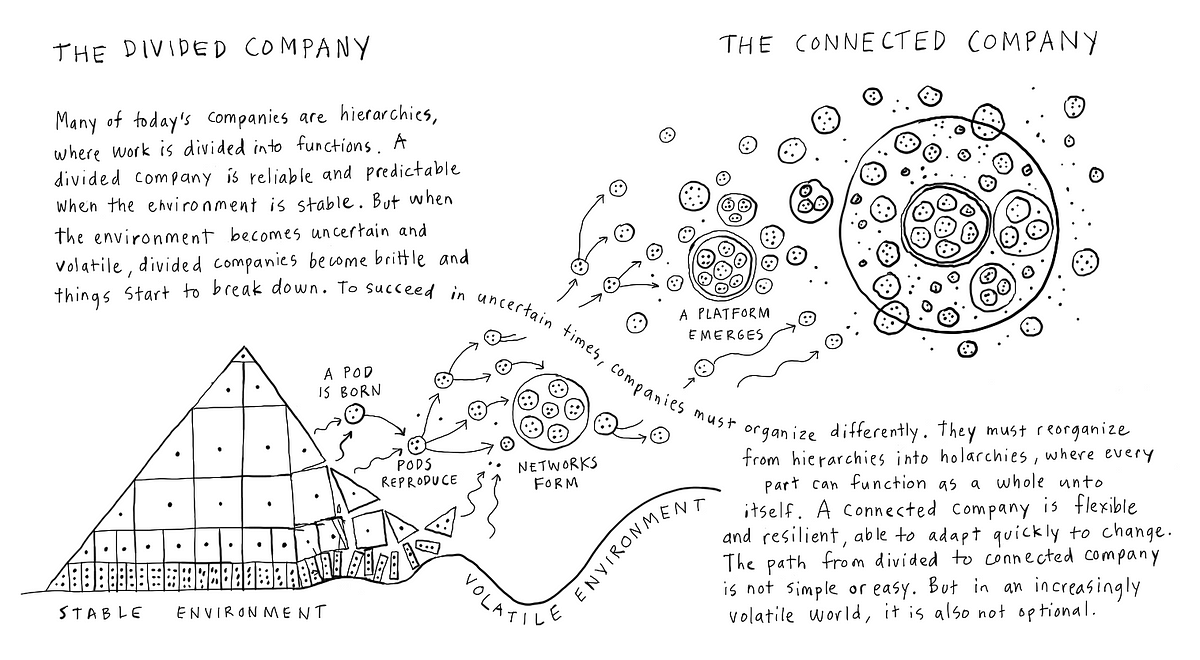A Proposal to Bridge the Gap Between Organizational Theory and Practice

“Harvard Business School doesn’t give a shit about Harvard Business Review.”
Referring to the separation between academic business schools and the business world, a graduate student in frustration of her field blurted this out as we were chatting at the Happiness & Well-Being San Diego pre-conference (a large academic psychology conference).
She told me she had ten years in strategy consulting before pursuing her PhD in Organizational Behavior at the prestigious Wharton Business School. I asked what brought her to San Diego at an academic psychology conference since she’s a business student. She responded,
“I’m sick of the business world. I needed to get away and better my ‘happiness’ and ‘well-being’.”
The Plan A
In the summer of 2013, I was introduced to Industrial/Organizational Psychology (I/O Psych), which is the psychology of people in the workplace. I/O psychologists in a nutshell help people be happier, healthier, and fulfilled at work.
It’s predicted to be the fastest growing career field until 2018. And given that 1) we spend about half of our waking hours at work, and 2) employee engagement hasn’t gotten any better the past 15 years, this projected career growth makes sense.
After finding out about I/O psych, I quickly realized the field is a game-changing opportunity to make a large impact in people’s lives. Since then, I decided to pursue my career in I/O and made it my goal to get admitted into an I/O Psych PhD program in 2017.
Then Along Came Organizational Design
My carefully-laid out career plans have changed, of course.
Thanks to the remarkable work pioneered by Undercurrent and the many communities attheforefront of this field, I’m enamored by organizational design. I haven’t stopped learning, thinking, and writing about it since finding out about it.
I would guess many different people in this space would define org design differently, but if we were to summarize it, org design is about preparing organizations to be responsive, adaptive, and capable for today’s rapidly changing world.

Our world’s current reality is disruptive innovation (like Uber dominating the taxi industry overnight) and complexity (due to a constant exponential increase in technology, information, and interconnectedness). We are in a digital era. And org designers argue that our traditional way of running organizations is meant for a 20th century Industrial Age, not today’s realities.
Orgs that dominate these exact challenges tend to be less of a bureaucratic, command-and-control hierarchy and more responsive, agile, and adaptive. Google, Tesla, and Netflix are well-known examples, but lesser-known organizational operating methodologies such as Holacracy, Spotify’s agile squads, Beta Orgs, and self-organizing teams are also helping companies organize for the future.
I blame org design for being a very fascinating, sexy field that has thwarted my I/O psych career plans. But really, to The Ready and NOBL whom have given me the opportunity to work with you, and to August, Nature of Work, Incandescent, OpenNest and many others whom have put their writing out there for me to learn from, thank you.
The Gap Between Org Theory and Practice
Both org academic and practitioner communities are striving to make work better. But I’ve noticed that both communities are very far apart.
Most org designers I’ve met haven’t heard of I/O psychology (and I don’t blame them). And my hunch is that not many I/O psychologists are aware of org design either.
Despite how true our Wharton graduate student’s opinion is on how HBS doesn’t care about HBR, let’s hopefully agree that there is a gap that exists between org theory and practice. Even if consultants know there are communitiesoforganizationalacademics out there, some don’t even give a crap about them.
What could be a factor of this theory-practice gap is the classic ivory tower problem: academics are simply way too far from the real world. Perhaps it’s less a gap between business schools and business and more a gap between academia and practice overall. Though I/O psychologists claim we’re a scientific-practitioner field, we may still be far from it being a practice.
Maybe the gap exists because org design’s thinking is too far in the future while academia has a tough time keeping up with today.
Or because the “Industrial” in “I/O” reeks of 20th century Taylorism to 21st century organizational designers.
Who knows.
Bridging the Gap
I’ve quoted this in my last piece, but it’s so on point that I’ll quote it again. Co-Founder at Thoughtful Org and former member of Zappos’ Holacracy implementation team Alexis GonzalesBlacksums up a good point about org design:
“There’s this whole other nut to crack in self-organization which is: How do you take care of people? And how do you make sure that people have really healthy ways to connect and to form identities and to be a part of something larger when we’re asking them to manage themselves?”
Your organizational operating model’s success is indicated by one thing: how much your people thrive from it. Alexis isn’tthe first to say this, either. Though us org designers may say we’re human-centric and all about people, clearly the mainstream doesn’t see that yet.
Maybe I’m trying way too hard to pull my two interests together, but I can’t help but think:
If a hefty amount of org design theory is aimed to bring out the “next stage of human consciousness”, shouldn’t we actually work with experts in human behavior? If we can do a better job of helping people, why shouldn’t we work with people experts?
If we’re all about basing our thinking on complexity science, why are we not working with actual scientists?
And on the flip side:
If I/O psych calls the field a scientific-practitioner model, why don’t more practitioners know of it?
And if I/O psych wants the real world to take our research and movement seriously, shouldn’t we spend more time in the real world?
As an incoming college grad, I have so much more experience to gain in both realms. But I know I’m not the first to say this: To further our mission of making work and the future of it better, we must bridge the gap between academia and the business world.
3 Starting Points to Build the Bridge
1. Organizational design firms should hire at least one behavioral scientist.
Most consulting firms formulate theory, do interviews, send out surveys, and evaluate how successful their consultations are. But to do all of these tasks optimally, you need trained scientists.
Scientists who can develop your theory, conduct unbiased interviews, crunch complicated statistical analyses, tap into past organizational research, and use data to evaluate the success of client projects. Scientists who have training from their PhD/M.S./M.A. in industrial/organizational psychology, organizational behavior, positive psychology, social psychology, and organizational science.
Firms could start small by working with a behavioral scientist on a freelance or internship basis. SYPartners is taking a step in this direction by hiring a behavioral research intern.
2. Graduate school programs should bring in practitioners to teach students and introduce them to the right folks.
A lot of I/O psychology and org behavior graduate programs do a great job of equipping its students with practical skills, but I think we could take it a step further and equip our students with entrepreneurial skills.
Students shouldn’t just be bombarded with forwarded emails of summer internship opportunities. Have org designers give workshops on why students should blog and how they could consult with future clients. Introduce them to folks in communities whom are currently involved in the business world.
3. Let’s start attending the same events.
I recently attended Responsive Org’s San Francisco Un-conference and it was fantastic (it was great to see a couple of grad students there, too).
There are tons of I/O & OB academic conferences and tons of org design conferences. We need to start attending the same events. Perhaps graduate students and professors could start attending these meet-ups and practitioners could start attending academic conferences.
And maybe one day, we could have a single conference for both communities.
As an incoming graduate, it’s nice to have some post-grad career clarity over the problem I want to help solve: Bridging this gap. Now I’ve got some work to do to get the right skills and experience.
Academic or practitioner, our purpose of making work (and the future of it) better will be best served when we work together.
Let’s make that happen.
